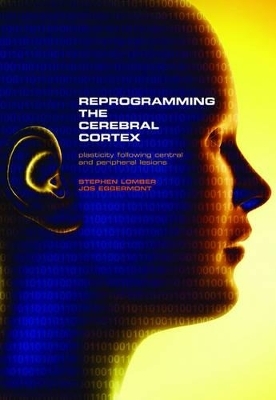
Reprogramming the Cerebral Cortex
Plasticity following central and peripheral lesions
Seiten
2006
Oxford University Press (Verlag)
978-0-19-852899-9 (ISBN)
Oxford University Press (Verlag)
978-0-19-852899-9 (ISBN)
The brains ability to adapt in the event of damage (cortical plasticity) is one of its remarkable characteristics. This book examines plasticity in a variety of systems, leading the reader through the complexities and promise of neuroplasticity, and presenting insights into current and future research and clinical practice.
The brain has a remarkable ability to adapt in the event of damage - in many cases shifting responsibility for specific cognitive functions to other non-damaged brain regions. This 'plasticity' can be crucial in aiding recovery from stroke, trauma, and peripheral damage such as eye or ear damage. Over the past thirty years our view of cortical plasticity has evolved greatly. Early studies suggested that changes to cortical function due to peripheral lesions could only occur during development and that these plastic changes were specific to a particular temporal window or "critical period". Over time, it has been demonstrated that cortical modifications as a consequence of either peripheral or central lesions can induce adaptive, or beneficial, changes in cortical function in an effort to preserve or enhance function. More recently, studies have identified that many of these adaptive changes, once thought only possible in the developing brain, are also possible in the mature or developed brain. At present, many laboratories are defining the beneficial capabilities of cerebral cortex plasticity, upon which many proactive and therapeutic strategies may be developed in order to maximiSe the "reprogramming" capabilities of the cerebrum.
'Reprogramming the Cerebral Cortex' describes these exciting studies and examines adaptive cortical plasticity in a variety of systems (visual, auditory, somatomotor, cross-modal, language and cognition). The book leads the reader through the complexities and promise of neuroplasticity, and presents insights into current and future research and clinical practice. It is unique in looking at the beneficial capabilities of cerebral cortex plasticity, upon which many proactive and therapeutic strategies may be developed.
The book will be a valuable resource for behavioural, systems, computational and cognitive neuroscientists, as well as clinicians and neuropsychologists.
The brain has a remarkable ability to adapt in the event of damage - in many cases shifting responsibility for specific cognitive functions to other non-damaged brain regions. This 'plasticity' can be crucial in aiding recovery from stroke, trauma, and peripheral damage such as eye or ear damage. Over the past thirty years our view of cortical plasticity has evolved greatly. Early studies suggested that changes to cortical function due to peripheral lesions could only occur during development and that these plastic changes were specific to a particular temporal window or "critical period". Over time, it has been demonstrated that cortical modifications as a consequence of either peripheral or central lesions can induce adaptive, or beneficial, changes in cortical function in an effort to preserve or enhance function. More recently, studies have identified that many of these adaptive changes, once thought only possible in the developing brain, are also possible in the mature or developed brain. At present, many laboratories are defining the beneficial capabilities of cerebral cortex plasticity, upon which many proactive and therapeutic strategies may be developed in order to maximiSe the "reprogramming" capabilities of the cerebrum.
'Reprogramming the Cerebral Cortex' describes these exciting studies and examines adaptive cortical plasticity in a variety of systems (visual, auditory, somatomotor, cross-modal, language and cognition). The book leads the reader through the complexities and promise of neuroplasticity, and presents insights into current and future research and clinical practice. It is unique in looking at the beneficial capabilities of cerebral cortex plasticity, upon which many proactive and therapeutic strategies may be developed.
The book will be a valuable resource for behavioural, systems, computational and cognitive neuroscientists, as well as clinicians and neuropsychologists.
VISION ; AUDITION ; SOMATOMOTOR ; CROSS-MODAL ; COGNITION
| Erscheint lt. Verlag | 12.10.2006 |
|---|---|
| Zusatzinfo | 104 figures, 15 black & white photos and 19 colour photos |
| Verlagsort | Oxford |
| Sprache | englisch |
| Maße | 175 x 253 mm |
| Gewicht | 952 g |
| Themenwelt | Geisteswissenschaften ► Psychologie ► Biopsychologie / Neurowissenschaften |
| Medizinische Fachgebiete ► Chirurgie ► Neurochirurgie | |
| Medizin / Pharmazie ► Medizinische Fachgebiete ► Neurologie | |
| Medizin / Pharmazie ► Medizinische Fachgebiete ► Psychiatrie / Psychotherapie | |
| Naturwissenschaften ► Biologie ► Zoologie | |
| ISBN-10 | 0-19-852899-X / 019852899X |
| ISBN-13 | 978-0-19-852899-9 / 9780198528999 |
| Zustand | Neuware |
| Haben Sie eine Frage zum Produkt? |
Mehr entdecken
aus dem Bereich
aus dem Bereich
Buch | Hardcover (2024)
De Gruyter (Verlag)
CHF 153,90
850 Fakten für die Zusatzbezeichnung
Buch | Softcover (2022)
Springer (Verlag)
CHF 65,80
Buch | Hardcover (2023)
Springer (Verlag)
CHF 307,95


